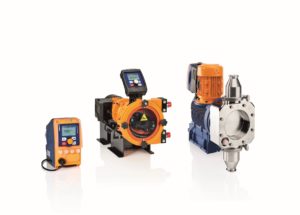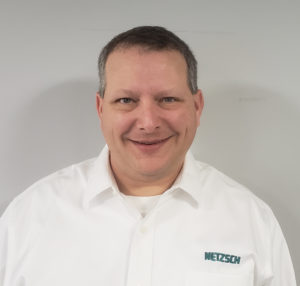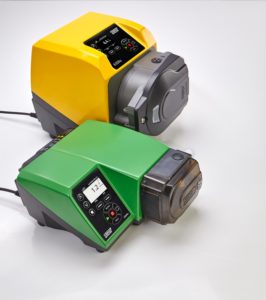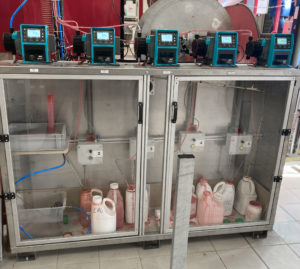Case Story: Blue White Peristaltic Pumps for Sodium Hypochlorite Injection
The quality of life for Americans was greatly enhanced in the early 1900’s due to the introduction of chlorinated drinking water throughout the United States water systems. From the stockyards of Chicago to the Boonton Reservoir of Jersey City, the case was established that filtration alone was not sufficient to guarantee clean water.
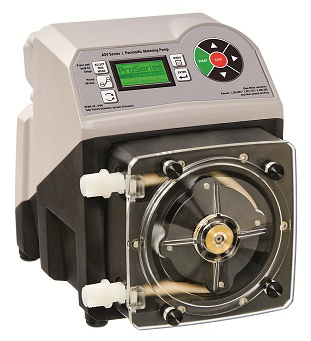
Weschem
By the 1920’s, chlorination was well entrenched as the primary means of disinfecting drinking water. The combination of filtration and chlorination reduced typhoid fever by 91% within five years which lead to its near eradication by 1936, according to a statistical study of disease rates.
Chlorine-based disinfectants have been the choice for treating drinking water since the turn of the 20th century. This is the only type of disinfectant that provides a residual in the distribution system that is vital to preventing waterborne diseases. Three forms of chlorine that are commonly used are: gaseous chlorine, calcium hypochlorite tablets, and sodium hypochlorite solution. However, safety concerns and costs have prompted many municipalities to switch from chlorine gas to sodium hypochlorite. The most common disinfection method is some form of chlorine or its compounds such as chloramine or chlorine dioxide. Other non-chlorine-based disinfectants are Ozone and UV radiation.
According to the Water Quality and Health Council, 98% of systems that treat water utilize chlorine-based disinfectants. Moreover, the World Health Organization concurs that disinfection by chlorine is still the best guarantee of microbiologically safe water.
Case Study
The Orange Water and Sewer Authority (OWSA) operates the Jones Ferry Road Water Treatment Plant, located in Chapel Hill, NC. The plant serves as a model for state of the art improvements and is routinely used as an engineering maintenance example for the engineering students studying at the local university and universities worldwide. The plant can treat up to 20 million gallons of raw water daily, nearly double the average demand of water usage from the local population of 70,000 people. The water treatment process encompasses several phases. The first phase is the addition of powdered carbon to the water supply from the lakes to improve the taste and control odour in the water. Secondly, the solid particles are separated from the water in settling tanks. Once that process is complete the water is pre-treated with sodium hypochlorite and then filtered through layers of sand and anthracite coal. Lastly, chemicals are added for disinfection and public health. The chemicals include chlorine, ammonia, and fluoride.
The pre-treatment stage consisted of a bank of ten diaphragm pumps injecting sodium hypochlorite continuously and simultaneously at a rate of 1.3 GPH against zero back pressure. OWSA noticed numerous problems with the diaphragm pumps in this particular application. The central issue was the outgassing or off gassing of the sodium hypochlorite and the inability of the diaphragm pump to operate efficiently due to the gas build- up in the pump head. Enviably, a loss of prime would occur, costing OWSA valuable down time. Despite the fact that auto-degassing valves were implemented, the problem was not totally eliminated. Consequently, the WTP chief operator, Dusty Martin, was compelled to make the switch to peristaltic pumps. He was enticed by the new technological developments that some of the peristaltic pumps featured, such as Blue-White’s Flex-Pro A3V model.
First and foremost, the Blue-White peristaltic pumps eliminate the core problem with outgassing of the sodium hypochlorite by utilizing precision engineered rollers to optimally squeeze a heavy duty Norprene tube with un-parallel accuracy and efficiently. Gas has no effect on this simplistic pumping method. Furthermore, the tube life has been greatly increased through an innovative rotor design that allows the pump to handle the same maximum pressure in either direction. The ability to reverse the motor, in essence, doubles the tube life. Of course, the tube life will always vary depending on the chemical used, the output pressure, the size of the tube, and the rpm of the motor. Other notable advancements with Blue-White’s Flex-Pro A3V model peristaltic pump include; a tube failure detection system built into the pump head, increase output pressure of up to 125 psi, precision SS ball bearings supporting the front and back of the rotor shaft, and highly advanced electronics to connect to Scada (Supervisory Control and Data Acquisition) systems.
At the Jones Ferry Road WTP, the Blue-White Flex-Pro A3V peristaltic pumps are wired via 4-20mA into the Scada system for monitoring and alarm responses. Martin stated that he was amazed how easily the peristaltic pump hooked up into their Scada system. Continual monitoring using powerful graphic and alarm software programs allow the Scada system to ensure the exact amount of chemicals have been dispersed into the water supply. In addition, Martin cites that the dosing is much more precise, accurate, and consistent using a peristaltic pump compared to a diaphragm pump. Overall, Martin highly recommends the Blue-White Flex-Pro A3V peristaltic pump over a diaphragm pump for sodium hypochlorite injection.
Source: WES Limited


